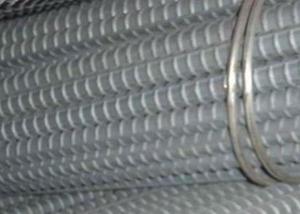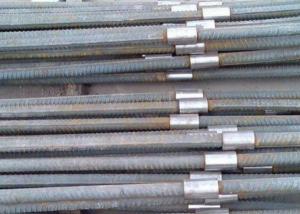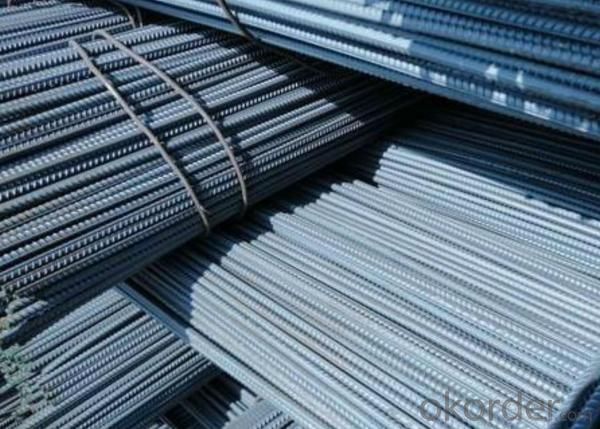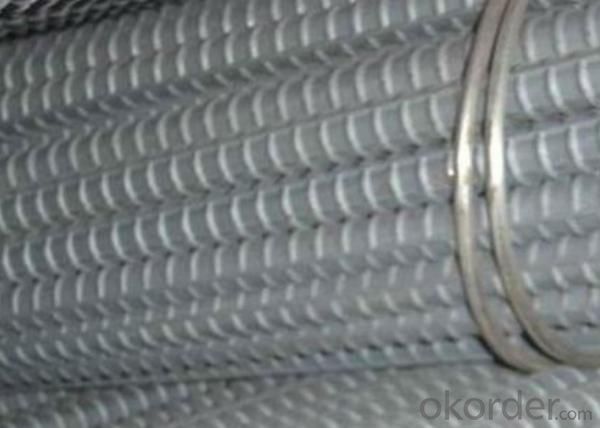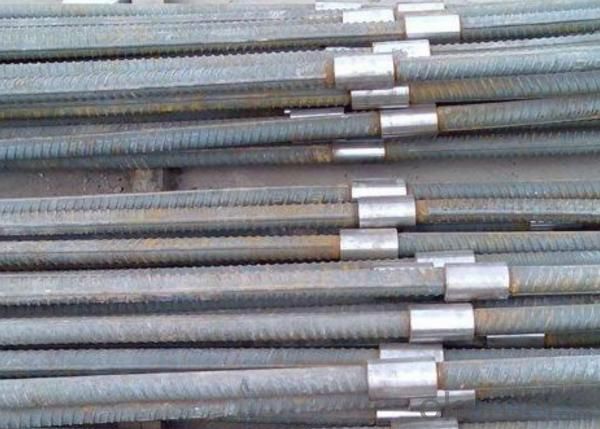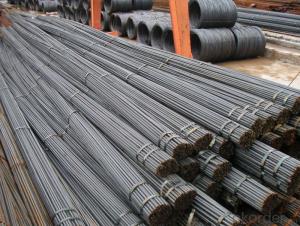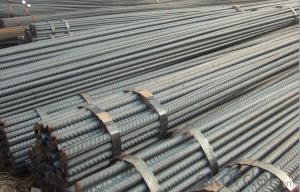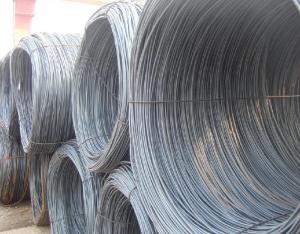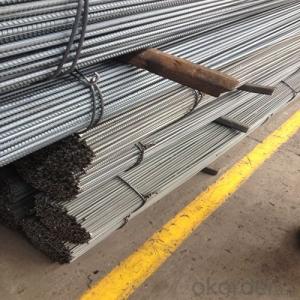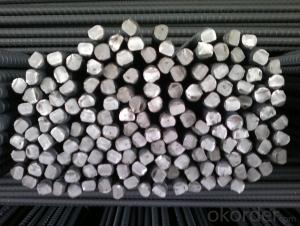HR Steel Rebar
- Loading Port:
- China Main Port
- Payment Terms:
- TT or LC
- Min Order Qty:
- 25MT m.t.
- Supply Capability:
- 800000MT/YEAR m.t./month
OKorder Service Pledge
OKorder Financial Service
You Might Also Like
Specifications of HR Steel Rebar:
Standard | GB | HRB335 HRB400 HRB500 | |
Diameter | 6mm,8mm,10mm,12mm,14mm,16mm,18mm,20mm, 22mm,25mm,28mm,32mm,36mm,40mm,50mm | ||
Length | 6M, 9M,12M or as required | ||
Payment term | TT or L/C | ||
Trade terms | FOB, CFR, CIF | ||
Application | Building, construction | ||
Quality | First quality, the goods are from Chinese big manufacturers. | ||
Type | Hot rolled steel rebar | ||
Brand name | DRAGON | ||
Chemical Composition: (Please kindly find our chemistry of our material based on HRB335, HRB400,HRB500 as below for your information)
Grade | Technical data of the original chemical composition (%) | |||||
C | Mn | Si | S | P | Ceq | |
HRB335 | ≤0.25 | ≤1.60 | ≤0.80 | ≤0.045 | ≤0.045 | 0.52 |
HRB400 | ≤0.25 | ≤1.60 | ≤0.80 | ≤0.045 | ≤0.045 | 0.54 |
HRB500 | ≤0.25 | ≤1.60 | ≤0.80 | ≤0.045 | ≤0.045 | 0.55 |
Theoretical weight and section area of each diameter as below for your information:
Diameter(mm) | Section area (mm²) | Mass(kg/m) |
6 | 28.27 | 0.222 |
8 | 50.27 | 0.395 |
10 | 78.54 | 0.617 |
12 | 113.1 | 0.888 |
14 | 153.9 | 1.21 |
16 | 201.1 | 1.58 |
18 | 254.5 | 2.00 |
20 | 314.2 | 2.47 |
22 | 380.1 | 2.98 |
25 | 490.9 | 3.85 |
28 | 615.8 | 4.83 |
32 | 804.2 | 6.31 |
36 | 1018 | 7.99 |
40 | 1257 | 9.87 |
50 | 1964 | 15.42 |
Usage and Applications of HR Steel Rebar:
Deformed bar is widely used in buildings, bridges, roads and other engineering construction. Big to highways, railways, bridges, culverts, tunnels, public facilities such as flood control, dam, small to housing construction, beam, column, wall and the foundation of the plate, deformed bar is an integral structure material. With the development of world economy and the vigorous development of infrastructure construction, real estate, the demand for deformed bar will be larger and larger..
Packaging & Delivery of HR Steel Rebar:
Packaging Detail: products are packed in bundle and then shipped by container or bulk vessel, deformed bar is usually naked strapping delivery, when storing, please pay attention to moisture proof. The performance of rust will produce adverse effect.
Each bundle weight: 2-3MT, or as required
Delivery Detail: within 45 days after received advanced payment or LC.
Label: to be specified by customer, generally, each bundle has 1-2 labels
Steel Rebar in stock

Steel Rebar in production line
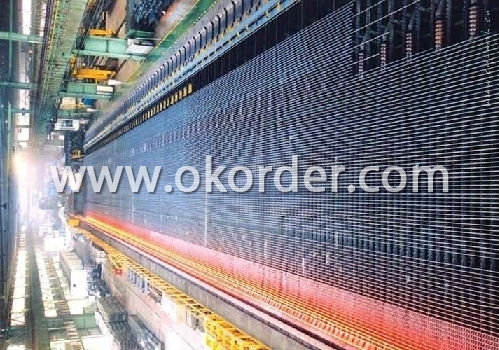
Note:
1. Our products are produced according to national standard (GB), if not, supply according to national standards (GB) or agreement as customer required.
2. Other Grade and Standard Deformed Steel Bar we can supply:
Grade: GR40/GR60, G460B/B500A/B500B/B500C,BST500S
Standard: ASTM, BS, DIN
The Minimum Order Quantity of these products is high, and need to be confirmed.
3. We can not only supply Deformed Steel Bar; if you need anything about building materials, please contact us for further information.
4. Please send us your detail specifications when inquire. We will reply to you as soon as possible. We sincerely hope we can establish a long stable business relationship.
- Q: What is the effect of welding on the properties of steel rebars?
- The effect of welding on the properties of steel rebars can vary depending on several factors. Firstly, welding can introduce heat into the rebars, which may cause localized changes in the material's microstructure. This can lead to changes in the rebars' mechanical properties, such as hardness and strength. The heat-affected zone (HAZ) near the weld can experience changes in grain structure, which may affect the rebars' ability to withstand tension, compression, or bending forces. Secondly, the welding process can introduce residual stresses into the rebars. This occurs due to the expansion and contraction of the material during the heating and cooling phases of welding. Residual stresses can potentially affect the rebars' performance under load, as they can increase the susceptibility to cracking or failure. Furthermore, welding can also introduce defects such as porosity, inclusions, or lack of fusion if not performed properly. These defects can weaken the rebars and reduce their load-bearing capacity. Additionally, the presence of welding consumables and fluxes can introduce impurities into the rebars, which may affect their corrosion resistance. Overall, while welding can be an effective method for joining steel rebars, it is crucial to consider the potential effects on their properties. Proper welding techniques, including preheating, controlling heat input, and post-weld heat treatment, can help minimize these effects and ensure that the rebars maintain their desired mechanical and structural properties. Regular inspections and testing of welded rebars are also important to ensure the integrity and safety of the overall structure.
- Q: Can steel rebars be used in structures with limited construction space?
- Yes, steel rebars can be used in structures with limited construction space. Steel rebars are commonly used in reinforced concrete structures to provide tensile strength and reinforce the overall structural integrity. Due to their small size and flexibility, steel rebars can be easily maneuvered and installed in tight spaces. They can be bent, cut, or shaped to fit the specific requirements of the construction project. Additionally, steel rebars can be prefabricated off-site and transported to the construction site, which further facilitates their use in limited construction spaces. Overall, steel rebars are a versatile and practical choice for reinforcing structures with limited construction space.
- Q: What is the typical lead time for ordering steel rebars?
- The lead time for ordering steel rebars can vary depending on various factors, such as the quantity required, the specific grade and size needed, and the availability and location of the supplier. Typically, if the rebars are readily available and in stock, the lead time can range from a few days to a couple of weeks, assuming the supplier has the necessary inventory and transportation logistics are straightforward. However, if the rebars require special manufacturing or are in high demand, the lead time can be longer. In such cases, it may take several weeks or even months to receive the rebars, especially for large or custom orders that involve special fabrication processes or if the supplier is facing production constraints. To obtain a more accurate estimate of the lead time, it is important to communicate with the supplier and provide them with all the necessary project requirements. It is also advisable to plan ahead and place the order well in advance, particularly for projects with strict deadlines, to ensure the timely arrival of the rebars.
- Q: How do steel rebars affect the overall sustainability of a construction project?
- Steel rebars can have a significant impact on the overall sustainability of a construction project. Firstly, steel rebars are commonly used to reinforce concrete structures, enhancing their strength and durability. By increasing the longevity of the building, steel rebars help minimize the need for frequent repairs or replacements, reducing the consumption of materials and energy required for maintenance over the long term. Moreover, steel rebars contribute to the structural integrity of a construction project, allowing for the design of lighter and more efficient structures. This results in reduced material usage, as well as lower energy consumption during the construction process. Additionally, the use of steel rebars can often lead to the construction of slimmer and more aesthetically appealing structures, which can have a positive impact on the environmental footprint of the project. Steel rebars are also recyclable, which further enhances the sustainability of a construction project. At the end of a building's life cycle, steel rebars can be easily recovered and reused, reducing the demand for new steel production. Recycling steel rebars not only conserves natural resources but also significantly reduces greenhouse gas emissions associated with the steel manufacturing process. Furthermore, steel rebars can contribute to the overall sustainability of a construction project by improving the building's resilience to natural disasters such as earthquakes or hurricanes. By providing additional strength and flexibility to the structure, steel rebars can help minimize damage and potentially save lives. In summary, steel rebars positively impact the overall sustainability of a construction project by enhancing the structural integrity and durability of buildings, reducing material and energy consumption, promoting recycling and reuse, and improving resilience to natural disasters. Their usage is a crucial component in creating more sustainable and environmentally friendly construction practices.
- Q: What is the role of steel rebars in basement wall construction?
- Steel rebars play a crucial role in basement wall construction by providing reinforcement and structural support to the concrete wall. Reinforcing bars, which are commonly made of carbon steel, are strategically positioned within the concrete prior to pouring. Their placement adds strength and stability to the wall, allowing it to withstand various external forces such as soil pressure and lateral forces. By distributing the load and forces that the wall may encounter, steel rebars prevent cracking or collapse under these pressures, ensuring the wall's durability and structural integrity. Additionally, they help control shrinkage and expansion of the concrete caused by temperature changes. By acting as a framework within the wall, the rebars limit the formation of cracks and maintain the overall stability of the structure. In summary, the inclusion of steel rebars significantly enhances the strength and durability of basement walls. They are essential for maintaining the integrity of the structure and safeguarding it against potential damage or failure.
- Q: What are the different types of steel rebars used in building construction?
- The different types of steel rebars used in building construction include plain carbon steel rebars, epoxy-coated rebars, galvanized rebars, stainless steel rebars, and high-strength rebars.
- Q: Are there any specific guidelines for handling and storing steel rebars?
- To ensure the quality and prevent any damage or accidents, specific guidelines exist for handling and storing steel rebars. Some of these guidelines include the following: 1. Use appropriate lifting equipment, such as cranes or forklifts, to handle the rebars and prevent strain or damage. Lift the rebars from the center to maintain balance and stability. 2. Before storing or using steel rebars, inspect them for defects like bends, cracks, or rust. Discard or repair any damaged or defective rebars before use. 3. Store steel rebars in a dry and well-ventilated area to prevent moisture accumulation and corrosion. Keep them off the ground on a flat surface, such as wooden pallets or racks, to avoid contact with soil or water. Take care when stacking rebars to prevent deformation or distortion. 4. Store different sizes and types of rebars separately to avoid mixing or confusion during use. Label or color-code the rebars for easy identification and retrieval. 5. Protect steel rebars from extreme temperatures, sunlight, and chemicals. Cover them with plastic sheets or tarpaulins to prevent moisture, dust, and debris from settling. 6. Securely tie or bundle steel rebars using appropriate strapping or wire during transportation. Avoid any impact or vibration that could cause damage. 7. Provide training on proper handling and storage techniques for steel rebars. Ensure personnel are aware of the hazards associated with improper handling and equipped with personal protective equipment (PPE) like gloves, safety boots, and helmets. By following these guidelines, you can ensure the quality and longevity of steel rebars, reduce the risk of accidents, and maintain a safe working environment.
- Q: Are steel rebars suitable for use in foundation structures?
- Indeed, foundation structures can benefit from the utilization of steel rebars. These rebars, also referred to as reinforcing bars, are commonly employed in concrete construction to bolster and reinforce the structure. By incorporating steel rebars into foundation structures, the load-bearing capacity and durability of the foundation can be significantly enhanced. Steel rebars are crafted from steel, a material renowned for its remarkable tensile strength and corrosion resistance. Consequently, steel proves to be an ideal substance for deployment in foundation structures. These rebars are seamlessly integrated into the concrete during the construction process, augmenting the strength of the foundation and preventing any potential cracks or fractures. Moreover, they serve to uniformly distribute the load throughout the foundation, thereby diminishing the likelihood of settlement or failure. Moreover, the flexibility of steel rebars allows for effortless customization to meet the specific requirements of the foundation structure. They are available in various sizes, shapes, and grades, enabling adaptability in design and construction. This adaptability renders steel rebars appropriate for implementation in diverse foundation structures, ranging from residential to commercial and industrial buildings. In conclusion, steel rebars represent a dependable and cost-effective choice for reinforcing foundation structures. They bolster the structural integrity and longevity of the foundation, ensuring the establishment of a robust and stable base for the entire edifice.
- Q: Can steel rebars be used in historical monument conservation?
- Yes, steel rebars can be used in historical monument conservation. They can be used to reinforce and strengthen the structures of historical monuments, ensuring their long-term stability and preservation. However, it is important to use appropriate and compatible materials to maintain the authenticity and historical integrity of the monument. Proper planning, expertise, and consultation with conservation experts are crucial in determining the best approach for incorporating steel rebars in historical monument conservation.
- Q: Can steel rebars be used in structures with limited foundation support?
- Yes, steel rebars can be used in structures with limited foundation support. Steel rebars are commonly used as reinforcement in concrete structures to enhance their strength and durability. They can help distribute the load more evenly across the structure, which can be particularly beneficial in situations where there is limited foundation support. However, it is important to assess the specific circumstances and consult with a structural engineer to ensure that the design and placement of the rebars are appropriate for the given foundation conditions.
1. Manufacturer Overview
| Location | Hebei, China |
| Year Established | 2002 |
| Annual Output Value | Above US$ 400 Million |
| Main Markets | South Asia; Middle East;Southeast Aisa |
| Company Certifications |
2. Manufacturer Certificates
| a) Certification Name | |
| Range | |
| Reference | |
| Validity Period |
3. Manufacturer Capability
| a) Trade Capacity | |
| Nearest Port | Tianjin |
| Export Percentage | 60%-80% |
| No.of Employees in Trade Department | 11-20 People |
| Language Spoken: | English; Chinese |
| b) Factory Information | |
| Factory Size: | Above 100,000 square meters |
| No. of Production Lines | 2 |
| Contract Manufacturing | OEM service offered |
| Product Price Range | average |
Send your message to us
HR Steel Rebar
- Loading Port:
- China Main Port
- Payment Terms:
- TT or LC
- Min Order Qty:
- 25MT m.t.
- Supply Capability:
- 800000MT/YEAR m.t./month
OKorder Service Pledge
OKorder Financial Service
Similar products
Hot products
Hot Searches
Related keywords

